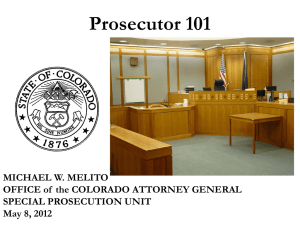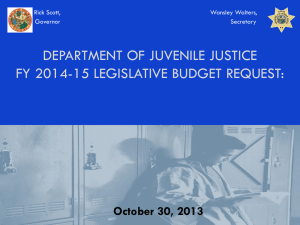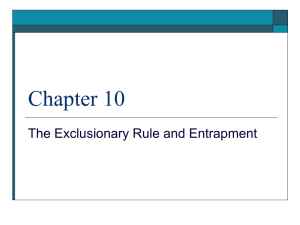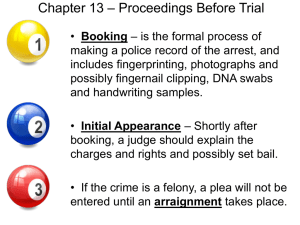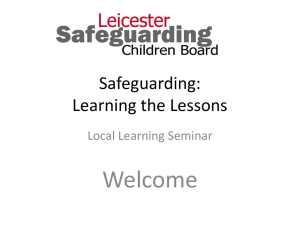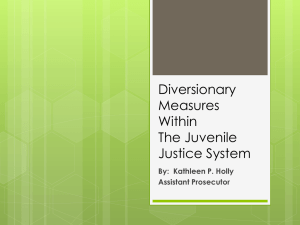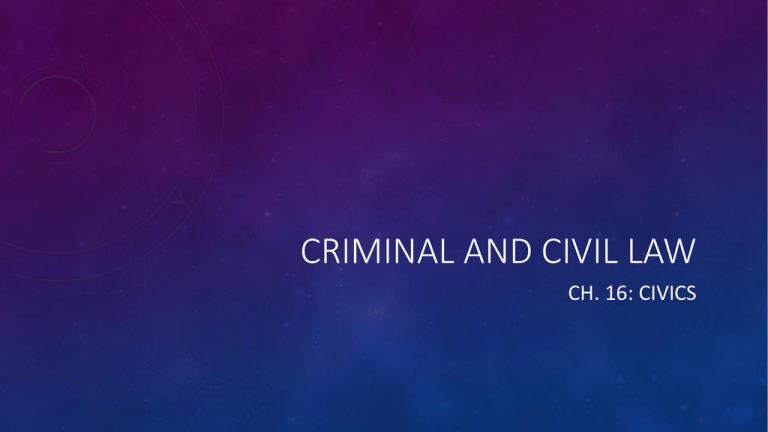
CRIMINAL AND CIVIL LAW
CH. 16: CIVICS
LESSON 1
DIRECTIONS: COMPLETE THE CHART INFORMATION ABOUT CIVIL LAW,
CRIMINAL LAW, AND THE JUVENILE JUSTICE SYSTEM.
Civil Law
Types of Cases
Parties Involved
Processes
Results
Criminal Law
Juvenile Justice
Disputes between parties
over contracts, property,
family issues, and personal
injury
Prosecutor and defendant
(accused person)
Custody, intake, detention
hearing, adjudication
hearing, disposition
hearing
Case dismissed, diversion,
acquittal, youth found
delinquent
Types of Cases
Parties Involved
Processes
Results
Civil Law
Criminal Law
Juvenile Justice
Disputes between parties
over contracts, property,
family issues, and personal
injury
Misdemeanors, felonies
Neglect of juvenile or
crime by juvenile
Plaintiff (who claims injury) Prosecutor and defendant
and defendant (accused of
(accused person)
causing injury)
Complaint, summons,
written answer, discovery,
trial, verdict
Arrest, preliminary
hearing, indictment,
arraignment, trial
Prosecutor and defendant
(juvenile)
Custody, intake, detention
hearing, adjudication
hearing, disposition
hearing
Settlement out of court, or Guilt by pleading guilty or Case dismissed, diversion,
trial with either party
through verdict or acquittal
acquittal, youth found
winning; defendant may
delinquent
have to pay damages
DIRECTIONS: READ EACH SCENARIO CAREFULLY. DECIDE
WHETHER CRIMINAL OR CIVIL LAW WOULD APPLY IF THE
MATTER WENT TO COURT.
• Scenario 1:
• A hospital patient dies. An investigation reveals that,
because of sloppy record keeping, the patient was given the
wrong dose of a medication.
• Answer: Civil Law
DIRECTIONS: READ EACH SCENARIO CAREFULLY. DECIDE
WHETHER CRIMINAL OR CIVIL LAW WOULD APPLY IF THE
MATTER WENT TO COURT.
• Scenario 2:
• A hospital patient dies. An investigation reveals that
someone secretly injected the patient with a deadly dose of
a medication.
• Answer: Criminal Law
DIRECTIONS: READ EACH SCENARIO CAREFULLY. DECIDE
WHETHER CRIMINAL OR CIVIL LAW WOULD APPLY IF THE
MATTER WENT TO COURT.
• Scenario 3:
• A tenant is three months behind in paying her rent. The
landlord uses his key to enter the tenant’s apartment when
she is not home. He takes money out of her desk drawer to
cover the back rent.
• Answer: Criminal Law
DIRECTIONS: READ EACH SCENARIO CAREFULLY. DECIDE
WHETHER CRIMINAL OR CIVIL LAW WOULD APPLY IF THE
MATTER WENT TO COURT.
• Scenario 4:
• A tenant is three months behind in paying her rent. The
landlord tells the tenant that she will have to pay the back
rent or move out of the apartment.
• Answer: Civil Law
DIRECTIONS: READ EACH SCENARIO CAREFULLY. DECIDE
WHETHER CRIMINAL OR CIVIL LAW WOULD APPLY IF THE
MATTER WENT TO COURT.
• Scenario 5:
• George goes to his neighbor Walter’s house to complain
that Walter’s icy sidewalk is dangerous for pedestrians.
Walking toward the front door, George slips and falls on the
icy driveway and breaks his hip.
• Answer: Civil Law
DIRECTIONS: READ EACH SCENARIO CAREFULLY. DECIDE
WHETHER CRIMINAL OR CIVIL LAW WOULD APPLY IF THE
MATTER WENT TO COURT.
• Scenario 6:
• George gets into an argument with his neighbor Walter,
complaining that Walter’s icy sidewalk is dangerous for
pedestrians. Walter gets angry and pushes George, who
falls down on Walter’s icy driveway and breaks his hip.
• Answer: Criminal Law
DIRECTIONS: READ EACH SCENARIO CAREFULLY. DECIDE
WHETHER CRIMINAL OR CIVIL LAW WOULD APPLY IF THE
MATTER WENT TO COURT.
• Scenario 7:
• An elderly millionaire dies, and in her will leaves all her
money to her butler. The millionaire’s children give evidence
that the butler poisoned their mother and forged her will.
• Answer: Criminal Law
DIRECTIONS: READ EACH SCENARIO CAREFULLY. DECIDE
WHETHER CRIMINAL OR CIVIL LAW WOULD APPLY IF THE
MATTER WENT TO COURT.
• Scenario 8:
• An elderly millionaire dies, and in her will leaves all her
money to her butler. The millionaire’s children claim that
the will is invalid because the butler forced their mother to
make him her heir.
• Answer: Civil Law
TYPES OF CIVIL LAW
• Contract Law: laws governing formal agreements between two or
more parties
• Property Law: laws governing the buying, selling, use, and upkeep
of real estate (land and buildings)
• Family Law: laws covering family relationships, including matters
such as birth, adoption, marriage, divorce, and death
• Personal Injury Law: laws covering wrongful actions that result in
injury to persons or damage to property
LESSON 1: SEQUENCING – COMPLETE A DIAGRAM LIKE THIS
ONE TO SHOW THE STEPS IN A LAWSUIT
PROPERTY LAW
• Most of the property laws that protect and regulate
homeowners are state and local laws. However, the federal
government can become involved in property matters.
Since the 1960s, there have been a number of federal fair
housing laws and presidential executive orders designed to
prevent discrimination based on race, color, national origin,
religion, age, sex, and family status in any transaction
involving the purchase or rental of property.
• The federal government is also likely to step in when the
nation is experiencing economic hardship. In February
2009, for example, President Barack Obama introduced a
plan to help homeowners. His “Making Home Affordable”
program set up ways for struggling homeowners to get
financial relief and avoid foreclosure.
IS IT NEGLIGENCE?
• Inside a grocery store, a wet,
slippery floor from a broken
and spilled gallon of milk
causes several shoppers to
slip and fall. Some of them
suffer minor injuries, such as
bruises and sprains.
• The store owner would be
considered negligent. Why?
• A traffic light is not working properly
after a strong thunderstorm.
Because both directions show green
lights, a minor accident occurs
between two drivers at the
intersection. The drivers should
have used greater caution in
approaching the intersection after
the storm.
• But the city is still found to be
negligent. Why?
1. Plaintiff’s attorney files
a complaint
CIVIL PROCESS
• What is a complaint?
• A. a notice for someone to appear in court to defend
themselves
• B. a formal notice that a lawsuit has been brought
• C. an agreement between parties to resolve a dispute
• D. a wrongful act for which an injured party has the
right to sue
• B. a formal
notice that a
lawsuit has
been brought
2. Court sends a summons
to defendant
CIVIL PROCESS
• When a court sends a summons to a defendant,
the defendant must
• A. appear in court to answer a complaint or a
charge
• B. agree to resolve a dispute
• C. pay for injuries or losses suffered
• D. check facts and gather evidence
• A. appear
in court to
answer a
complaint
or a charge
3. Defendant’s attorney
files a written answer
CIVIL PROCESS
• Who is the defendant?
• A. the person who files a lawsuit
• B. the person who has suffered an injury or a loss
• C. the person who is being sued
• D. the person who serves a formal notice that a
lawsuit has been filed
• C. the
person
who is
being
sued
4. Attorney’s for both
sides exchange pleading
documents
CIVIL PROCESS
• After the attorneys have exchanged pleading
documents, they have an opportunity to check
facts and gather evidence. This process is known as
• A. tort
• B. summons
• C. settlement
• D. discovery
• D. discovery
5. Attorney’s for plaintiff
and defendant argue cases
in court
CIVIL PROCESS
• One of the major differences between criminal and
civil trials is that in civil trials,
• A. both the plaintiff and the defendant are
represented by attorneys
• B. the plaintiff has to present a preponderance of
evidence
• C. either a judge or a jury may decide the case
• D. the defendant may appeal the verdict
• B. the plaintiff
has to present a
preponderance
of evidence
6. Court gives a verdict
CIVIL PROCESS
• A court verdict is a
• A. formal notice that a lawsuit has been brought
• B. decision of the court
• C. notice directing someone to appear in court
• D. process by which lawyers check facts and gather
evidence
• B.
decision
of the
court
LESSON 2
SENTENCING OPTIONS
Severe
Punishment
• Execution – Convicted person is sentenced to die;
this form of punishment is not permitted in some
states
• Imprisonment – Convicted person is sentenced to
jail or prison
• Work Release – Convicted person works in the
community, but returns to jail at night or on
weekends
• House Arrest – Sentence is served at home; the
person must wear an electronic device that allows
authorities to track his or her location
• Community Service – Convicted person completes
a certain number of hours of unpaid, supervised
work that benefits the local community.
Milder
Punishment
• Probation – Convicted person is released but
monitored by a probation officer
• Suspended Sentence – Sentence does not have to
be served unless the person gets into more
trouble with the law
• Fine – Convicted person pays the government a
sum of money set by the court
• Restitution – Convicted person pays back or
makes up for whatever loss was suffered by the
victim of the crime or the victim’s family.
• Community Service – Convicted person
completes a certain number of hours of unpaid,
supervised work that benefits the local
community.
SEQUENCING: AS YOU READ, CREATE A DIAGRAM SHOWING WHAT TAKES PLACE
IN A CRIMINAL CASE AFTER AN ARREST HAS BEEN MADE.
FINGERPRINTING
• People in different parts of the world have used fingerprinting for thousands
of years. It was first used in the United States in 1882 by surveyor Gilbert
Thompson. He put his own prints on a survey to prevent forgery. After that,
it wasn’t long before law enforcement agencies caught on to fingerprinting.
• By the turn of the 20th century, federal, state, and local police departments
in the United States were using fingerprints to help solve crimes. In 1924,
the Federal Bureau of Investigations (FBI) centralized fingerprinting files,
making it much easier to identify repeat criminals.
• Today, the FBI uses a computerized system to keep the fingerprints of more
than 34 million criminals on file. Soon, new technology may allow law
enforcement officers to fingerprint suspects in the field.
LESSON THREE
Juvenile Justice
INTERNET EMAIL SCAM AND CYBER BULLIES
HIGH SCHOOL DROPOUTS
Every 29 seconds, another student gives up on
school. More than one million American high
school students drop out every year.
Dropouts earn $9,200 less per year than high
school graduates and more than 1 million less
over a lifetime than college graduates.
Students who
failed to
graduate with
their class
70%
30%
Students who
graduate with
their class
There are nearly 2,000 high schools in the
United States where 40% of the typical
freshman class leaves school by its senior
year.
Dropouts are more likely than high school
graduates to be in poor health, on public
assistance, and single parents of children who
also drop out of high school.
Dropouts were more than twice as likely as
high school graduates to slip into poverty in a
single year and three times more likely than
college graduates to be unemployed.
DIRECTIONS: WRITE THE STEPS OF THE JUVENILE
PROCESS IN THE CHART.
Step 1:
Step 2:
Step 3:
Step 4:
Step 5:
DIRECTIONS: WRITE THE STEPS OF THE JUVENILE
PROCESS IN THE CHART.
Step 1: Arrest – Juvenile is taken into custody
Step 2: Intake – A social worker decides how the juvenile’s case should
be handled
Step 3: Detention Hearing: The state shows there is a good reason to
believe the juvenile committed the offense
Step 4: Adjudication Hearing: This hearing is similar to an adult trial,
but closed to the public
Step 5: Disposition Hearing: This hearing is similar to a sentencing
hearing in an adult case
JUVENILE JUSTICE HISTORY
• Before 1825: Juvenile criminals were punished and confined the same way as
adults.
• 1825 – 1899: Juvenile offenders were confined in youth-only facilities known
as “houses of refuge” and “reform schools.”
• 1899 – 1925: States set up juvenile court systems
• 1925 – 1967: Juvenile cases were treated as civil, not criminal, cases; acting
in the “best interests of the child,” juvenile courts could order juveniles
removed from their homes
• 1967 – 1971: Supreme Court extended due process protections to juveniles
• 1990s – Now: There is a trend toward trying juvenile offenders as adults



